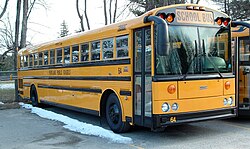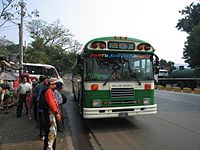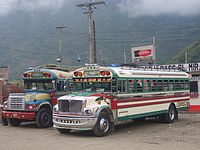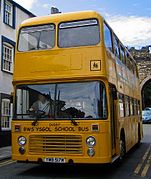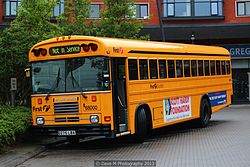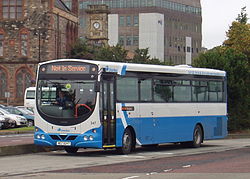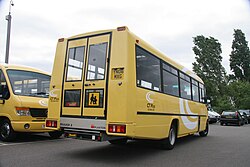School bus
This article may be too long to read and navigate comfortably. (February 2013) |
| School bus | |
|---|---|
 Front 3/4 view of a typical North American school bus (IC Bus CE-Series) | |
| Overview | |
| Manufacturer | List of school bus manufacturers |
| Body and chassis | |
| Doors | Front entry/exit door; rear/side emergency exit door(s) |
| Chassis | Cutaway van Cowled chassis Stripped chassis |
| Powertrain | |
| Engine | Various fuel types (see article) |
| Capacity | 10-90 passengers, depending on floor plan |
| Transmission |
|
| Dimensions | |
| Length | Up to 45 feet (13.7 m) |
| Width | Up to 102 inches (2,591 mm) |
| Curb weight | ≤10,000–36,000 pounds (4,536–16,329 kg) (GVWR) |
| Chronology | |
| Predecessor | Kid hacks |
A school bus (also called schoolbus) in North America is a type of bus specifically designed and manufactured for student transport: carrying students to and from school and school events. School buses provide an estimated 10 billion student trips every year; over half of the USA's student population is transported by school bus. Each school day in 2013, nearly 468,000 school buses transported 28.8 million children to and from school and school-related activities; over half of the United States K-12 student population is transported by school bus.[1][2][3]
School buses in North America are distinguished from other bus types by design characteristics mandated by federal and state regulations. Federal safety standards in the United States and Canada require school buses to be painted school bus yellow and to be equipped with specific warning and safety devices.[4]
Outside North America, the term is applied to any bus used for a dedicated school student transport service; it may be a bus used for this purpose typically at the start and end of the school day, or an older bus or coach retrofitted as a dedicated school bus.
Design history
Early history
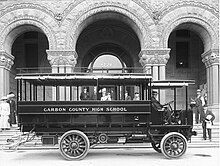
In the second half of the 19th century, many rural areas of the United States and Canada were served by one-room schools. For those students who lived beyond practical walking distance from school, transportation was facilitated in the form of the kid hack; at the time, "hack" was a term referring to certain types of horse-drawn carriages.[5] While some kid hacks were essentially repurposed farm wagons, others were purpose-built for transporting people instead of cargo, featuring bench-type seating. As these were horse-drawn vehicles, the entrance door was rear-mounted (in order to avoid startling the horses when loading or unloading passengers). Later one of the longest-running school bus manufacturers, Wayne Works (later Wayne Corporation), started producing its first school wagons in Indiana in 1886.[6]
Early 20th century


Following the transition to "horseless carriages", kid hacks switched from horse-drawn wagons to motorized vehicles based on automotive chassis. In terms of design, little changed, as many early school bus bodies essentially remained wagons mounted to truck frames; the rear entry door and perimeter seating remained. Weather protection was nearly non-existent; if it all, it consisted of a tarpaulin stretched above the passenger area.
In 1927, Ford dealership owner A.L. Luce produced a bus body for a 1927 Ford Model T. Unlike previous wood-bodied motorized buses, Luce used primarily steel panels with a wood frame; this would be the first bus produced by what would later become bus manufacturer Blue Bird. While the bus was constructed with a roof, its only weather protection was afforded by roll-up canvas side curtains.
In 1930, Wayne Works introduced the first all-steel school bus body with safety glass windows;[5] Other manufacturers continued using curtains until the 1930s.[7]
The 1930s would mark a major transition in the overall layout of vehicles used for school transportation. Instead of adapting other vehicles (such as wagons, carriages, trucks) to accommodate student passengers, school buses were becoming distinct, dedicated vehicles. Part of this was reflected in the body configuration. By the end of the 1920s, for ease of boarding and improved visibility, the entry door of school buses was moved from the rear to the front curbside corner. However, in a nod to their kid hack roots, the rear door would remain (as an emergency exit).
As school bus design paralleled truck design, the advent of forward-control trucks would have their own influence on school bus design. In an effort to gain extra seating capacity and visibility, Crown Coach built its own cabover school bus design from the ground up.[7][8][9] The highest-capacity school bus of the time,[8] the 76-passenger Crown Supercoach was aptly named, as many California school districts operated in terrain requiring heavy-duty vehicles.[9] As the 1930s progressed, flat-front school buses began to follow motorcoach design in styling as well as engineering, partially the reason the industry adopted "transit-style" in naming them. In 1940, the first mid-engined transit school bus was produced by Gillig in California.[10]
Developing production standards
The custom-built nature of school buses created an inherent obstacle to their profitable mass production on a large scale. Although the design of school buses had largely moved away from kid hacks, by the end of the 1930s, there was not yet an agreed upon set of industry-wide standards for school buses. A 1939 conference at Teachers College, Columbia University organized by rural education expert Dr. Frank W. Cyr forever changed the design and production of school buses; it was attended by transportation officials, representatives from body and chassis manufacturers, and paint companies.[11]
The conference resulted in a set of 44 standards adopted by all manufacturers (interior dimensions, seating configuration). Many of those standards allowed for consistency among body manufacturers, reducing the complexity of production as well as the price of their products; large-scale production was now possible. While many of the standards have been modified or updated, one lasting result of the conference remains part of every school bus in North America today: the adoption of a standard paint color for all school buses. While technically named National School Bus Glossy Yellow, school bus yellow was adopted for use since it was considered easiest to see in dawn and dusk, and it contrasted well with black lettering.[11] While not universally used worldwide, yellow has become the shade most commonly associated with school buses both in North America and abroad.[12][13]
Later 20th century




Evolving demand
In the years following World War II, two factors in the United States affect demand for student transportation and school buses. In rural areas, one-room schools from the turn of the century had all but disappeared; larger schools with graded class structures had taken their place. As schools consolidated and relocated further apart from rural residents, walking to school became impractical, particularly as students progressed into high school. As the baby boom generation began their education, school populations rapidly increased, which coincided from the movement from urban to suburban areas. From the beginning of the 1950s into the 1970s, the rapid population growth of the baby-boom generation would create a built-in demand for school bus production.
Although the need for student transportation and school buses was driven by overall population growth and the shift to suburban areas, in large urban areas, another factor would lead to an increase for the need for busing of students. During the 1970s, several large cities had become court-ordered to bus students in an effort to racially integrate schools, which forced them to expand their bus usage.
Following the end of the 1970s, demand for school buses in North America was significantly decreased by several factors. By 1980, nearly the entire baby-boom generation had completed high school, moving into college or the workforce. Due to closures and competition among industry manufacturers, production of bus bodies was largely limited to six major body manufacturers (Blue Bird Body Company, Carpenter Body Works, Superior Coach Company, Thomas Built Buses, Inc., Wayne Corporation, and Ward Body Works) with chassis produced by three truck manufacturers Ford, General Motors, and International Harvester. By 1965, Diamond T, REO, Mack, and White had ended school bus chassis production, leaving it to four companies: Chevrolet/GMC, Dodge (Fargo in Canada), Ford (and Mercury in Canada), and International Harvester; in 1977, Dodge ended heavy truck production as part of Chrysler Corporation's financial difficulties.
Coupled with the fragile economy of the early 1980s, the overcapacity of school bus production left several manufacturers in financial ruin. To increase their chances for survival, several manufacturers filed for bankruptcy or were purchased by other manufacturers. One of the few new firms that gained entry into the industry was Freightliner, who became a chassis supplier in the late 1990s. After 2001, only three of the original "Big Six" had survived (Blue Bird, Thomas, and Ward, which was reorganized twice, first as AmTran and later IC Corporation/IC Bus).
After the 2001 closure of Carpenter, General Motors and Ford were gradually shut out of the full-size school bus industry. After building its last bus chassis in 1998, an agreement with Ford to supply Blue Bird with bus chassis fell through in 2002. General Motors, unable to find a body manufacturer to buy its chassis, produced its last full-size school bus chassis in 2003. Today, GM and Ford remain in the industry as the exclusive chassis suppliers for Type A school buses.
Design innovations
After World War II, transit-style school buses would see increased interest as they offered increased capacity and visibility; some were designed for heavy-duty use.[9] A new generation evolved as Blue Bird developed the first version of its All American in 1948. Soon after, redesigned versions of the Crown Supercoach and the Gillig Transit Coach were introduced.[10] Transit-style school buses offered a potential solution to the increase in student populations, as their higher capacities (eventually up to 97 passengers) meant that fewer buses needed to be driven and maintained, offsetting their higher initial purchase price.
As before, truck manufacturing would further influence school buses. In 1954, the first diesel-powered school bus was produced; a year later, the first tandem-rear axle school bus was constructed (both were Crown Supercoaches).[7] In 1959, Gillig Bros. introduced the rear-engine diesel-powered school bus; soon afterwards, the Gillig Transit Coach School Bus became the most popular example of the type on the West Coast.[10] With the availability of heavier-duty chassis, the size of buses began to grow. Towards the end of the 1950s, to accommodate wheelchair-bound passengers, wheelchair lifts were designed as an optional feature along with wheelchair tie-downs.
As full-size school buses grew larger during the 1950s and early 1960s, they became difficult to navigate the crowded, narrow streets of urban neighborhoods; other rural routes were extremely isolated, with roads that could not accommodate full-size buses. To fill this role, yellow-painted vehicles such as the International Travelall and Chevrolet Suburban came into use. As they entered production in the 1960s, passenger vans were converted to school bus use, largely by the use of warning lights and yellow paint. A drawback to using passenger vans and utility vehicles is that along with their lower seating capacity, they could not offer the same level of safety as a full-size school bus. The design of the small school bus changed in 1973 when Wayne introduced the Busette. The first school bus to utilize a cutaway van chassis design, the Busette differed from previous vehicles in its ability to utilize a scaled-down version of the passenger compartment design used on its full-size school buses. In 1973, the Wayne Busette became the first school bus based on a cutaway van chassis design; a scaled-down bus body took the place of the van body; the design of the Busette would quickly be followed by other bus manufacturers. By the end of the decade, other bus manufacturers would develop their own bodies for GM and Ford cutaway vans; some bus manufacturers would get their start specializing solely in small buses. On a heavier-duty scale, bus manufacturers also developed buses utilizing the chassis of a delivery van/step van, which allowed for the body to be the same width of a full-size school bus. For the transportation of special-needs students, small school buses are often equipped with automated lifts for wheelchair-bound passengers unable to climb steps into the bus. In addition to the driver, these buses often have attendants or aides on board to deal with physical or mental issues of student passengers.
As a result of the 1970s fuel shortages, steps were also taken to improve the fuel economy of school buses. In the 1980s, manufacturers began to include diesel engines as options in conventional and small school buses; previously, diesel engines were considered a premium option only used on transit-style school buses. In 1986, Navistar International became the first chassis manufacturer to phase out gasoline engines entirely. Other manufacturers followed suit, and diesel engines replaced gasoline engines in virtually all full-size school buses by the mid-1990s.
The demand for better forward visibility and better turning radius led to a major expansion of market share for transit-style school buses in the late 1980s and early 1990s. Initially, this was led by the 1986 Wayne Lifestar; however, the AmTran Genesis, Blue Bird TC/2000, and Thomas Saf-T-Liner MVP would prove far more successful. In 1996, AmTran introduced the AmTran RE, the first low-cost rear-engine school bus.
Focus on safety
During the 1970s, the school bus would begin to see many updates related to safety. To increase safety around school bus stops and decrease confusion over traffic priority, several states began to adopt the use of amber warning lamps inboard of the traditional red ones. Activated 100–300 feet before stopping, the amber lights are intended to show drivers that a school bus is about to drop off or load students. In addition, to keep drivers from passing a stopped school bus in low visibility, the stop arm on the side of the bus was given a set of flashing lights.
As the school bus evolved as a specialized vehicle in the United States and Canada, concerns arose for the protection of passengers in major traffic collisions. In catastrophic school bus accidents, a particular structural weak point turned out to be the body joints where panels and pieces were fastened together. Since the 1930s, longitudinal steel guardrails were a feature protecting the sides of buses. Underneath the guardrails, bus manufacturers combined numerous steel panels to form the body of the bus; the panels were usually attached to the internal body structure by rivets or similar fasteners such as huckbolts.
After subjecting a bus to a rollover test in 1967, Ward Body Works discovered that bus construction of the time resulted in panel separation in body joints during a rollover crash; the company pointed out that many of their competitors were using relatively few rivets and fasteners. In contrast, Wayne Corporation found from its own data that regardless of the number of fasteners used, the body joints themselves were the weak points. As a result, to reduce the risk of body panel separation, side panels began to be constructed from fewer and larger stampings. In 1973, the Wayne Lifeguard became the first school bus to virtually eliminate body joints; its body was constructed by single-stamping side (and roof) panels. While single-piece stampings seen in the Lifegaurd had their own manufacturing challenges, school buses of today use relatively few side panels to minimize body joints. In the 21st century, the Thomas Saf-T-Liner C2 would demonstrate the first use of adhesive bonding to join body panels and minimizing the need for rivets.
The focus on structural integrity influenced new requirements in the U.S. Federal Motor Vehicle Safety Standards for school buses, most of which became applicable for school buses on April 1, 1977. These new federal standards brought significant change to the design, engineering, and construction of school buses and a substantial improvement in safety performance. Most visibly, these standards —known as Federal Motor Vehicle Safety Standards for School Buses— mandated taller seats and thick padding on the front and back. Under the sheetmetal, the internal structure of virtually all school bus designs were required to be strengthened for improved crashworthiness.
Further improvement has resulted from continuing efforts by the U.S. National Highway Traffic Safety Administration (NHTSA) and Transport Canada, as well as by the bus industry and various safety advocates. As of 2014, all of these standards are still in effect.[14] In 1986, with the signing of the Commercial Motor Vehicle Safety Act, school bus drivers across the United States became required to acquire a commercial driver's license (CDL); while still issued by individual states, the federal CDL requirement ensured that drivers of large vehicles such as school buses have a consistent training level.[6] School buses are generally considered Class C vehicles with passenger and namesake endorsements, but the highest-capacity versions require a Class B license (based on their higher GVWR).
| Standard Name | Effective Date | Requirement |
|---|---|---|
| Standard No. 217 - Bus Emergency Exits and Window Retention and Release | September 1, 1973 | This established requirements for bus window retention and release to reduce the likelihood of passenger ejection in crashes, and for emergency exits to facilitate passenger exit in emergencies. It also requires that each school bus have an interlock system to prevent the engine starting if an emergency door is locked, and an alarm that sounds if an emergency door is not fully closed while the engine is running. |
| Standard No. 220 - School Bus Rollover Protection | April 1, 1977 | This established performance requirements for school bus rollover protection, to reduce deaths and injuries from failure of a school bus body structure to withstand forces encountered in rollover crashes. |
| Standard No. 221 - School Bus Body Joint Strength | April 1, 1977 | This established requirements for the strength of the body panel joints in school bus bodies, to reduce deaths and injuries resulting from structural collapse of school bus bodies during crashes. |
| Standard No. 222 - School Bus Passenger Seating and Crash Protection | April 1, 1977 | This established occupant protection requirements for school bus passenger seating and restraining barriers, to reduce deaths and injuries from the impact of school bus occupants against structures within the vehicle during crashes and sudden driving maneuvers. |
| Standard No. 301 - Fuel System Integrity - School Buses | April 1, 1977 | This specified requirements for the integrity of motor vehicle fuel systems, to reduce the likelihood of fuel spillage and resultant fires during and after crashes. |
During the 1980s and 1990s, safety would become a highlight of many school bus redesigns and model introductions. To increase loading-zone visibility, the design of bus bodies began to move the driver upward, outboard, and forward; windshields grew larger in size. Improving the ergonomics of the drivers' compartment was intended to decrease driver distraction, which led to improved layouts of controls and switches. To avoid stalling in stop-and-go driving (and in potentially dangerous places such as intersections or railroad crossings), automatic transmissions had begun to replace manual transmissions during the 1980s.
School buses of the 21st century

By the beginning of the 21st century, manufacturer consolidation and industry contraction would necessitate production changes among remaining school bus manufacturers. Gone were the days of customers picking and choosing school bus body and chassis separately; the acquisition of AmTran and Thomas along with the General Motors supply arrangement with Blue Bird had reduced the separate combinations available to build. Although the aspect of choice was disappearing, the decreased complexity paved the way for new product innovations previously thought impossible.
In the past, conventional-style buses were bodied on a chassis supplied by a separate manufacturer. For 2004, two manufacturers introduced conventional-body school buses that integrated both body and chassis within a single manufacturer. Blue Bird introduced the Vision; in the fashion of the All American, the chassis was designed by the company specifically for bus use and built in its own factory. Thomas Built Buses introduced the Thomas Saf-T-Liner C2; although the chassis was derived from the Freightliner Business Class M2, the chassis and the body of the C2 were designed together as a unique vehicle. A key trait of both the Vision and the C2 was improved visibility around the loading zone; both vehicles feature highly sloped hoods and extra glass around the entry door of the bus.
After being shut out of full-size bus production, General Motors and Ford became the sole chassis providers of small buses after the discontinuation of the Dodge Ram Van in 2003. After the sale of the General Motors P-chassis to Navistar subsidiary Workhorse in 1998, Type B buses began to disappear. In their place, cutaway versions of Class 4-5 trucks began to appear; various school buses utilized Chevrolet/GMC C4500 and International 3200 cutaway cabs. In 2006, IC Bus introduced the BE200, the first Type B bus with a fully cowled chassis (a scaled-down Type C body). In 2010, IC introduced the AE-Series; based on the International TerraStar, it is the first cutaway chassis school bus not based upon a Ford, GM, or Dodge chassis in North America since International's own 3400 school bus chassis, last produced in 2001. Fairfax County Public Schools in Virginia has the largest school bus fleet in the country
As during the 1990s, mergers and acquisitions would continue to influence school bus production; however, aside from the failure of startup manufacturer Liberty Bus, contraction was largely absent. In 2007, Collins Bus Corporation, the largest independent manufacturer of Type A buses, acquired Canadian manufacturer Corbeil out of bankruptcy. Corbeil joined Ohio-based manufacturer Mid Bus as a Collins subsidiary; manufacturing of all three product lines was consolidated at the Kansas factory owned by Collins. In 2009, Blue Bird and Girardin entered into a joint venture; Girardin now produces the entire small-bus product line for Blue Bird.[15]
In 2009, Starcraft Bus expanded into school bus production; after producing conversions of Dodge Ram vans from 2000 to 2001, Starcraft introduced a full-scale line of cutaway-van school buses; in 2010, the company produced its first prototype of a full-size school bus (based on a Hino 338 chassis). In 2011, Lion Bus of Saint-Jérôme, Quebec marked the return of full-size bus production to Canada. In partnership with Spartan Motors,[16] Lion was the first all-new manufacturer of full-size school buses in 19 years. Lion has a single conventional-style school bus; in an unusual move to combat corrosion, its body was designed primarily with composite panels in place of the traditionally-used steel.
Design innovations

The late 2000s have seen a variety of innovations introduced into school bus design; some changes are aimed at improving their environmental impact while others are intended to improve school bus safety. Several manufacturers have introduced hybrid school buses while alternatives to diesel fuel are also being explored. Seatbelts, always a controversial topic, have become more common in school buses; buses with 3-point seatbelts have been introduced. School bus crossing arms, first introduced in the late 1990s, have been adopted by a number of jurisdictions.
Electronics have started to play an expanded role in school bus operation. To increase child safety and security, alarm systems have been developed to prevent children from being left on unattended school buses overnight.[17]
In the past decade, onboard GPS tracking devices have taken on a dual role of fleet management and location tracking. Not only does GPS tracking allow for internal management of costs, but it can be used to alert waiting parents and students of the real-time location of their bus.[18] This is in use in the United States as well as worldwide markets, such as India.[19]
Manufacturing
This section needs additional citations for verification. (September 2010) |
In most cases, school bus body companies function as second stage manufacturers. However, some school buses (typically those of Type D configuration) have both the body and chassis produced from a single manufacturer. In 2013, 36,073 school buses were sold in North America, a 12.6% increase over 2012.[1]
Production (North America)
In the United States, school buses are currently produced by six different manufacturers. Three of them—Collins Industries, Starcraft Bus, and Trans Tech—specialize exclusively in small buses, while two—IC Bus and Thomas Built Buses—produce both small and large buses. Blue Bird Corporation produces only full-size buses; its small buses are produced by Canadian manufacturer Girardin. Along with the United States, Canada has its own history of school bus production. Currently, it is home to Girardin Minibus, which produces small buses for Blue Bird as part of a joint venture. Since 2011, Lion Bus has produced full-size Type C school buses for both Canadian and U.S. operators.
In the past, Canada was home to facilities of several U.S. firms (Blue Bird, Thomas, Wayne); Canadian-produced school buses were exported to the United States, and Canada imported many U.S.-produced buses. Domestically, the Quebec-based firm Corbeil manufactured full-size and small school buses from 1985 to 2007; in 2008, it was purchased by Collins Industries.
Types of school buses
The North American school bus industry produces buses in four different body configurations, listed alphabetically (along with trade name). All school buses in North America are of single deck design. In the United States, school buses are restricted to a maximum width of 102 in (2,590.8 mm) and a maximum length of 45 ft (13.72 m).[20] Depending on specifications, school buses are currently designed with a seating capacity with up to 90 passengers.
School bus safety
Since the initial development of consistent school bus standards in 1939, many of the ensuing changes to school buses over the past 75 years have been safety related, particularly in response to more stringent regulations adopted by state and federal governments. Ever since the adoption of yellow as a standard color, school buses deliberately integrate the concept of conspicuity into their design. When making student dropoffs or pickups, traffic law gives school buses priority over other vehicles; in order to stop traffic, they are equipped with flashing lights and a stop sign.
As a consequence of their size, school buses have a number of blind spots which endanger passengers disembarking the bus and pedestrians standing or walking nearby. This safety challenge is addressed by improving the design and configuration of the bus windows, windshield, body panels, and mirrors in order to maximize visibility. In the case of an accident, the body structure of a school bus is designed with an integral roll cage along with a number of emergency exits to facilitate fast egress. Controversy exists over the use of seat belts as a restraint system for school bus passengers; officials of the U.S. National Transportation Safety Board state school buses are safer than private automobiles even if they are not fitted with seat belts.[23]
Visibility

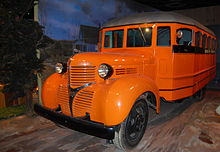
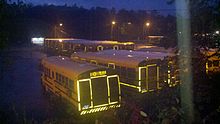
A key priority for a bus driver when driving as well as when loading and unloading students is proper sightlines around their vehicle; the blind spots formed by the school bus can be a significant risk to bus drivers, traffic, as well as pedestrians. In the United States, approximately ⅔ of students killed outside of the school bus are not struck by other vehicles, but by their own bus.[24]
To combat this problem, school buses are specified with sophisticated and comprehensive mirror systems. In addition, driver visibility and overall sightlines have become important considerations in vehicle redesigns; in comparison to past models, newer buses have much larger windscreens and fewer blind spots.
School bus yellow
Yellow was adopted as a standard color for North American school buses beginning in 1939. In April of that year, Dr. Frank W. Cyr, a professor at Teachers College at Columbia University in New York organized a meeting to establish national school bus construction standards, including the adoption of a standard shade of paint. The color which became known as "school bus yellow" was selected because black lettering on that specific hue was easiest to see in the semi-darkness of early morning and late afternoon. Officially, it is designated "National School Bus Chrome" (later renamed "National School Bus Glossy Yellow" as the lead was removed from the pigment).
Although it is not a government specification outside of the United States and Canada, school buses outside North America sometimes feature some shade of yellow in part or in whole, And while some areas without school services have conducted evaluations of American yellow style school buses,[25] other governments require their own distinctive paint schemes, often favouring other high visibility colours such as white or orange[13][26] that may better suit their own climate or conditions.
Retroreflective markings
School buses often operate in low-visibility conditions such as early morning or in poor weather as well as in rural areas. While their yellow paint color does give them a conspicuity advantage over other vehicles, darkness can make them hard to see. To improve their visibility, many state and provincial governments (for example, Colorado)[27] require the use of retroflective tape on school buses. Marking the length, width, height, and in some cases, identifying the bus as a school bus, reflective tape makes the vehicle easier to see for other drivers by the light of their headlamps and correctly perceive its size and position.
Federal Motor Vehicle Safety Standard 217 also requires that yellow, white, or red retroreflective tape be applied so as to mark all emergency exits, so rescue personnel can quickly find them in darkness.[28] The equivalent in Canada is almost identical; the only difference is that red cannot be used as a retroreflective color.
Traffic priority
By the mid-1940s, most states had traffic laws requiring motorists to stop for school buses while children were loading or unloading.[citation needed] The justifications for this protocol are:
- Children, especially the younger ones, have normally not yet developed the mental capacity to fully comprehend the hazards and consequences of street-crossing, and under U.S. tort laws, a child cannot legally be held accountable for negligence. For the same reason, adult crossing guards often are deployed in walking zones between homes and schools.
- It is impractical in many cases to avoid children crossing the traveled portions of roadways after leaving a school bus or to have an adult accompany them.
- The size of a school bus generally limits visibility for both the children and motorists during loading and unloading.
Since at least the mid-1970s, all U.S. states and Canadian provinces and territories have some sort of school bus traffic stop law; although each jurisdiction requires traffic to stop for a school bus loading and unloading passengers, different jurisdictions have different requirements of when to stop. Outside of North America, the school bus stopping traffic to unload and load children is not provided for. Instead of being given traffic priority, fellow drivers are encouraged to drive with extra caution around school buses.
Warning lights and stop arms
This section needs additional citations for verification. (June 2014) |

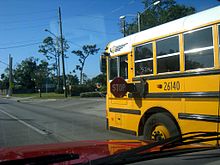
Around 1946, the first system of traffic warning signal lights on school buses was used in Virginia. This system comprised a pair of sealed beam lights similar to those employed in American headlamps of the time. Instead of colorless glass lenses, the warning lights utilized red lenses. A motorized rotary switch applied power alternately to the red lights mounted at the left and right of the front and rear of the bus, creating a wig-wag effect. Activation was typically through a mechanical switch attached to the door control. However, on some buses (such as Gillig's Transit Coach models and the Kenworth-Pacific School Coach) activation of the roof warning lamp system was through the use of a pressure-sensitive switch on a manually controlled stop paddle lever located to the left of the driver's seat below the window. Whenever the pressure was relieved by extending the stop paddle, the electrical current was activated to the relay. Plastic lenses for warning lights were developed in the 1950s, though sealed beams — now with colorless glass lenses — were still most commonly used behind them until the mid-2000s, when light-emitting diodes (LEDs) began supplanting the sealed beams.
With the adoption of FMVSS 108 in January 1968, four additional warning lights were gradually added to school buses; these were amber in color and mounted inboard of the red warning lights.[29] Intended to signal an upcoming stop to drivers, as the entry door was opened at the stop, they were wired to be overridden by the red lights and the stop sign.[29] Although 8-light systems were adopted by many states and provinces during the 1970s and 1980s, the all-red systems remain in use by some locales, such as Wisconsin, Saskatchewan and Ontario, Canada, as well as older buses in California.
To aid visibility of the bus in inclement weather, school districts and school bus operators add flashing strobe lights to the roof of the bus. Some states (for example, Illinois)[30] require strobe lights as part of their local specifications.
During the early 1950s, states began to specify a mechanical stop signal arm which the driver would swing out from the left side of the bus to warn traffic of a stop in progress. The portion of the stop arm protruding in front of traffic was initially a rectangle with stop painted on it. The U.S. National Highway Traffic Safety Administration's Federal Motor Vehicle Safety Standard No. 131 regulates the specifications of the stop arm as a double-faced regulation octagonal red stop sign at least 45 cm (17.7 in) across, with white border and uppercase legend. It must be retroreflective and/or equipped with alternately flashing red lights. As an alternative, the stop legend itself may also flash; this is commonly achieved with red LEDs.[31] FMVSS 131 stipulates that the stop signal arm be installed on the left side of the bus, and placed such that when it is extended, the arm is perpendicular to the side of the bus, with the top edge of the sign parallel to and within 6 inches (15 cm) of a horizontal plane tangent to the bottom edge of the first passenger window frame behind the driver's window, and that the vertical center of the stop signal arm must be no more than 9 inches (23 cm) from the side of the bus. One stop signal arm is required; a second may also be installed.[31] The second stop arm, when it is present, is usually mounted near the rear of the bus, and is not permitted to bear a stop or any other legend on the side facing forward when deployed.[31]
The Canadian standard defined in Canada Motor Vehicle Safety Standard No. 131, is substantially identical to the U.S. standard.[32]
Safety devices


In addition to the warning devices that allow them to stop traffic around them when picking up or dropping off students, school buses are also equipped with a number of different safety devices to prevent accidents or injuries and for the purposes of security.
For the purposes of evacuation, school buses are equipped with a minimum of at least one emergency exit in addition to the main entry door. The rear-mounted emergency exit door is a design feature retained from when school buses were horse-drawn wagons and the entrance door was rear-mounted to avoid frightening the horses; in rear-engine school buses, the door is replaced by an exit window supplemented by a side-mounted exit door. Additional exits may be located in the roof (roof hatches), window exits, and/or side emergency exit doors. All are opened by the use of quick-release latches which activate an alarm. The number of emergency exits in a school bus depends on the size of the bus (its seating capacity) along with individual state regulations; Kentucky requires the most, with each full-size school bus having a total of eight emergency exits in addition to the entry door.
To inhibit pedestrians from walking close enough to the front of the bus that the hood obscures them from the driver's view, North Carolina and Connecticut are examples of states that requiring school buses to be equipped with crossing arms. These are devices which extend from the front bumper while the bus is stopped for loading or unloading.[33] By design, these force passengers to walk forward several feet forward of the bus (into the view of the driver) before they can walk across the road.
In the past, handrails in the entry way posed a potential risk to students; as they exited the bus, items such as drawstrings or other loose clothing could be caught if the driver was unaware and pulled away with the student caught in the door. To minimize this risk, school bus manufacturers have redesigned handrails and equipment in the stepwell area. In its School Bus Handrail Handbook, the NHTSA described a simple test procedure for identifying unsafe stepwell handrails.[34]
During the past two decades, video cameras have become common equipment installed inside school buses, primarily to monitor and record passengers' behavior. Video cameras have also been useful in determining the causes of accidents: on March 28, 2000, a Murray County, Georgia, school bus was hit by a CSX freight train at an unsignaled railroad crossing; three children were killed. The bus driver claimed to have stopped and looked for approaching trains before proceeding across the tracks, as is required by law, but the onboard camera recorded that the bus had in fact not stopped.[35]
As digital recording devices replace VHS cameras, a single device is replaced by multiple cameras throughout the bus, allowing for surveillance from multiple vantage points. Exterior-mounted cameras are mounted on the bus to photograph vehicles illegally passing the school bus when its stop arm and warning lights are in use (thus committing a moving violation).
Restraints and seating
Seat belts
In contrast to cars and other light duty passenger vehicles, school buses are typically not equipped with seat belts. In 1977, as provided in Federal Motor Vehicle Standard 222, the U.S. federal government required passive restraint and more stringent structural integrity standards for school buses instead of requiring lap seat belts. The passive restraint standards exempted school buses with a gross vehicle weight (GVWR) of over 10,000 pounds from requiring seat belts. A revised FMVSS 222 was set to take effect in October 2011 to require three-point, lap/shoulder belts in all newly manufactured Type A small school buses to improve occupant protection. The revised standard also introduces standards for testing lap/shoulder belt-equipped bus seats and the anchor points for the optional installation of these seat-belt systems in large school buses. Where in the past FMVSS 222 seat belt equipped seats could reduce passenger capacity by up to one third, NHTSA is recognizing new technology that allows belting either three smaller children or two larger children per seat.[36][37]
Whether seat belts should be a requirement has been controversial.[38] However, in October 2013, NASDPTS most recently stated at their annual transportation conference (NAPT) that they now fully support three-point lap-shoulder seat belts on school buses.[39] Currently, they are a requirement in at least five states:[40]
- Florida
- New Jersey (see below)
- New York
- California
- Texas
Of the states that equip buses with two-point lap seat belts (Florida, Louisiana, New Jersey and New York), only New Jersey requires seat belt usage by riders.[41] In other states, it is up to the district whether to require riders to use them or not.
In July 2004, California became the first state to require three-point lap/shoulder seat belts on all new Type A small school buses. A year later, this requirement was extended to large Type C and Type D school buses. Texas had planned a voluntary adoption of seat belts in newly purchased large school buses by 2010, with the state reiumbursing school districts for the additional costs. However, due to budget cuts, only 36% of the planned funding was allocated for the extra costs[42]
Compartmentalization
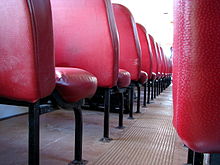
As a concept, compartmentalization was introduced in 1967 by safety researchers at UCLA. The premise behind compartmentalization is that improved seat design with high-back padded seats spaced close together (a maximum of 24 inches (61 cm) apart front to back) would better contain passengers in the event of a crash. Although not an element of compartmentalization, the UCLA researchers who conducted the 1967 tests on school buses concluded that after high back seats, next in importance to school bus passenger collision safety is the use of a three-point belt, a lap belt or other form of effective restraint. In April 1977, Federal Motor Vehicle Standard 222 changed the design of school bus seats from low metal-backed seats to the thickly padded seats still in use today.[37]
While compartmentalization is designed to help protect passengers in frontal and rear impact situations,[43] it does little to protect passengers in a side impact or rollover scenario.[44][45] Even in the situations where compartmentalization is designed to help protect passengers (front and rear impacts), injuries can still occur.[46]
Environmental compatibility
In theory, school buses reduce pollution in the same manner that carpooling does but on a much larger scale; in total, it is estimated that the approximately 480,000 school buses in the United States do the job of 17.3 million cars when it comes to transporting students.[47] However, as they are powered by internal-combustion engines, school buses are not a completely pollution-free method of transportation like biking or walking.
Some of the environmental drawbacks of school busing stem from the idling of engines while waiting for students to be unloaded and loaded at bus stops and at school. Since most school buses use diesel fuel, people standing or walking near the bus are exposed to exhaust fumes, which are believed to lead to health problems. Some older buses have been retrofitted with upgraded emission controls and diesel particulate filters,[48] and new buses meet more rigorous emissions standards with more advanced engines and emission control strategies such as Selective catalytic reduction; a bus meeting 2007-model year emissions standards is 60 times cleaner than a bus from 1990.[48]
Alternative fuels

Although diesel fuel is most commonly used in large school buses (and even in many smaller ones), alternatives such as LPG/propane and CNG have been developed to counter the drawbacks that diesel and gasoline-fueled school buses pose to the environment.
As a result of the 1970s energy crisis, propane conversions of gasoline engines were made available in the late 1970s and 1980s (most commonly those used in the General Motors B-Series). These conversions fell out of favor due to stability of gasoline prices and the increasing usage of diesel engines. In the late 2000s, as increasingly stringent emissions regulations affected the performance of diesel engines, propane-fueled powertrains regained interest. In 2009, Blue Bird Corporation became the first manufacturer to offer an optional propane-fueled engine as original-equipment specification;[49] in 2013, Thomas Built Buses launched its own propane-fueled variant of the Saf-T-Liner C2.
As a source of fuel, compressed natural gas was first introduced in school buses by Blue Bird in 1991,[49] using a variant of the Cummins C8.3 inline-6 diesel engine. Along with the Thomas Saf-T-Liner HDX, the current version of the rear-engine Blue Bird All American today uses a variant of the Cummins ISL-G as a CNG option.[49][50]
Hybrid-electric and battery-powered school buses
IC Bus, in collaboration with Enova Systems, unveiled the nation's first hybrid electric school bus in 2006 at the New York Association of Pupil Transportation (NYAPT) Show. This plug-in hybrid-electric vehicle (PHEV) school bus is claimed to reduce fuel consumption by as much as 40 percent compared to ordinary diesel buses.
Eleven states joined together for an exploratory purchase of 19 of these school buses from IC Bus. New York, California, Texas, Florida, Pennsylvania, Virginia, North Carolina, South Carolina, Arkansas, Iowa and Washington were the first states in the nation to test the diesel-electric hybrid school buses.[51] Since then, hybrids have slowly gained acceptance in the marketplace nationwide as the price premium has come down. Hybrids generally cost about $200,000 as of spring 2011, compared to more than $100,000 for a regular-sized diesel school bus.[52]
During the 1990s, battery-powered school buses were developed as conversions of existing vehicles; only a few were made, primarily for research purposes. In 2012, Trans Tech Bus introduced the eTrans, the first series-produced school bus that was battery-powered. Based upon the Newton truck from Smith Electric Vehicles, the eTrans was designed with an approximate range of 130 miles between charges.[53] In 2013, Trans Tech developed the SST-e, a conversion of a Type A school bus using the Ford E-Series rolling chassis.
Other uses
As a result of their large size and sturdy construction, vehicles built from school bus bodies are desirable for many other uses outside of student transport.
In education
An "activity bus" is a school bus used for providing transportation for students. Instead of being used in route service (home to school), the intended usage of an activity bus is for transporting students for extracurricular activities. Depending on individual state and provincial regulations, the bus used for this purpose can either be a regular yellow school bus or a dedicated unit for this purpose. Dedicated activity buses, while not painted yellow, are fitted with the similar interiors as well as the same traffic control devices for dropping off students (at other schools).
Multi-function school activity bus (MFSAB)

In the past, groups transporting children and adults that did not need (or afford) a large bus commonly used 15-passenger vans to handle their transportation. However, such vehicles were at a disadvantage by comparison in terms of meeting safety regulations. To provide an alternative to 15-passenger vans (called "non-conforming vans" because they do not meet any safety standards for school buses),[54] bus manufacturers have designed vehicles as alternatives to 15-passenger vans. These are called Multi-Function School Activity Buses (MFSABs).
The basic design of MFSABs differs from yellow school buses because of their intended use. As they are intended for point-to-point transportation instead of route service, MFSABs are not fitted with traffic control devices (i.e., red warning lights, stop arm) nor are they painted school bus yellow.[55] MFSAB buses are typically based on Type A school buses, although manufacturers offer MFSAB configurations for full-size buses as well.
For educational use, MFSABs are primarily used for extracurricular activities requiring transportation; in the private sector, they are typically purchased by child-care centers.
In law enforcement

Larger police agencies may own their own buses for transporting large numbers of officers for a number of reasons. As these often offer higher capacity seating than other buses, the vehicles employed are based on school buses. Other police buses are custom-built as mobile command centers, using school bus bodyshells. Other uses by law enforcement often involve prisoner transport vehicles.
In community outreach

With their large interior size, the body shells of school buses are among one of the most common type of bases for bookmobiles and mobile blood donation centers (bloodmobiles). Bookmobiles feature interior shelving for books and library equipment; bloodmobiles feature mobile phlebotomy stations and blood storage. Both types of vehicles spend long periods of time in the same place; to reduce fuel consumption, they often have on-board electrical generators to power their interior equipment and climate control.
In church use
Throughout the United States and Canada, school buses that are retired from front-line service have seen a second life as church buses; some churches purchase their buses new. While these buses are used to transport both adults and children, their usage as church buses varies from state to state. Buses converted to non-school use are prohibited by federal safety standards from displaying the "School Bus" lettering. Stop arms and signal lamps must be disabled or removed.[4] In some states, the bus is required to change its color from School Bus Yellow.
In church use, traffic law rarely gives buses priority to stop traffic. Alabama, Arkansas, Kentucky, Tennessee, and Virginia[56] are the only American states where school bus stop laws are similarly applied to church buses, if equipped with the flashing red lights used on school buses and operated in compliance with the same regulations as school buses. ((-))
Retirement
This section possibly contains original research. (May 2009) |

School buses are retired from service based on their age; some states and provinces have a specific age or mileage interval calling for their retirement, regardless of condition. In other cases, school districts and bus operators have a vehicle replacement schedule removing buses from service when it no longer is cost-effective to keep them in reliable and safe condition. Many buses that are retired are scrapped for spare parts; others are sold to such entities as churches, resorts or camps. School buses, as with other types of buses, are sometimes preserved and restored to their original condition by collectors and bus enthusiasts; museums and collectors have an interest in older and rarer models. Additionally, restored school buses appear alongside other period vehicles in television or film. Some retired school buses are converted into recreational vehicles (RVs); enthusiasts of this type of vehicle conversion are sometimes called Skoolies.
Former school buses may also be converted into farm utility vehicles for cattle feeding, fruit orchard maintenance and harvest, and other tasks. Most of the roof and body sides are removed, leaving only a cab for the driver enclosed with a rear wall. This creates a truck with an extremely long, flat bed. Many farms also use unconverted school buses (with usually just the name of the school district it once served and the "School Bus" lettering on the front and back blacked out) to transport their migrant workforce.
After their retirement from school use, NHTSA regulations require that the stop arms and warning signals of a school bus be removed or disabled.[4] In addition, if the bus is to transport passengers, the body must be painted a color other than School Bus Yellow and all school bus lettering must be removed.[4]
Export
Some retired school buses are exported to Latin America, Africa, or elsewhere. They are used as public transportation, school buses, municipal transport, or for the transport of migrant farmworkers. Once they are exported, their new owners often update the color scheme from school bus yellow to a variety of different colors.
School buses around the world

Outside of North America, the yellow school bus is not as common; buses used for the purpose of student transport are typically closer in design to mass-transit buses. These buses may be painted yellow or other similar shades, but school bus yellow is not a government specification like it is on school buses from the United States or Canada and so is generally seen only on buses imported from North America. School buses outside of North America typically do not have traffic priority while loading or unloading students; school bus traffic stop laws differ from North American counterparts (if they exist at all).
China
Mainland China
In mainland China, purpose-built vehicles for transporting schoolchildren are not commonly used. Due to lack of buses and absence of regulation, overloading of buses with children in China for school routes is commonplace.[57] Consequently, accidents happen frequently.
Some Chinese bus manufacturers, such as Zhengzhou Yutong Group Co., Ltd., developed a school bus model, the ZK6100DA, to be purchased by schools in China. It was described as a "big-nose school bus" with a "classic western-style appearance" by one online newspaper.[58] FAW developed the similar CA6750. Both school buses hold approximately 35 student passengers.[59] In addition to large school buses, minibuses are sold by Chengdu and Maxus;[59] these school buses hold from 16 to 24 passengers.
In February 2012, the potential of American-imported school buses was explored as American manufacturers Blue Bird and IC Bus (Navistar) displayed buses at a bus industry trade show in Beijing.[60]
Hong Kong
In Hong Kong, younger students are transported between their homes and schools by "nanny vans". These vehicles are typically van-based and are smaller than a minibus. When nanny vans originated, they were regulated primarily by the schools and the van drivers. Today, in the interest of safety, nanny vans are government-regulated vehicles that run on fixed routes.
Singapore
In Singapore, student transport by bus is usually provided by local scheduled public transport bus services such as 31, 72, 88, 179 and 199; and also various train services. Dedicated bus services for school students are usually contracted out to local bus companies, using ordinary buses which are used for other purposes when not in use for school journeys.
Examples of school buses used in Singapore include:
- Alexander Dennis Enviro200Dart single deckers
- Alexander Dennis Enviro300 single deckers
- Alexander Dennis Enviro400 double deckers
- DAF DB250LF/Alexander ALX400 double deckers
- DAF DB250LF/Plaxton President double deckers
- Dennis Trident 2/Alexander ALX400 double deckers
- Higer Bus coaches
- King Long coaches
- MAN NG363F bendy buses
- MAN NL323F single deckers (Gemiliang and Wright Meridian)
- Mercedes-Benz O530 Citaro single deckers
- Scania K230UB single deckers
- Scania OmniCity double deckers
- Scania OmniDekka double deckers
- Volvo B5TL/Wright Eclipse Gemini 3 double deckers
- Volvo B7RLE/MCV Evolution single deckers
- Volvo B7TL/Alexander ALX400 double deckers
- Volvo B7TL/Plaxton President double deckers
- Volvo B9TL/Wright Eclipse Gemini 2 double deckers
- Wright StreetDeck double deckers
- Wright StreetLite single deckers
- Yutong ZK6126 single deckers and standard coaches
Europe
Germany

In Germany, students travel to school on scheduled public train and bus routes. In most cases, these services operate at times to suit school hours and are not run during weekends and holiday periods, though the services are open to use by non-school-related travellers. Local authorities subsidise the routes but parents or guardians are required to pay a contribution to the cost of a season ticket for use of the services. Many scholars use their own bicycles to travel to school and may take these with them when a part of the journey is by train.
As student transport is heavily dependent on the public transport system in urban areas, most students are transported on mass-transit or intercity buses along with minibuses in support. To distinguish themselves from other buses, routes that transport students are required to have a destination sign worded "Schulbus" with a yellow background. German traffic law gives traffic priority to school buses unloading and loading students; school buses are to warn traffic using their four-way hazard lights.
The maximum speed for German school buses varies. While coaches are typically limited to 80 kilometres per hour (50 mph), any buses with standing passengers are limited to 60 kilometres per hour (37 mph).
Italy

In Italy, school buses are typically painted yellow or orange. The vehicles used for student transport are usually minibuses or midibuses. As in North America, school buses run on fixed routes and stops.
While only a legal requirement for bus transporting Materne (preschool) students, school bus drivers are provided with an aide to manage the students on the bus.
Poland
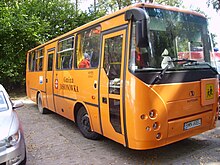
In Poland, school buses are used in a similar fashion as those in the United States, to connect residents of rural areas to schools located far away. While officially lettered autobus szkolny (Polish for "school bus"), they are colloquially known as gimbus.
Along with their counterparts in North America, school buses in Poland have several design features to differentiate them from standard buses. First, all school buses are painted orange. Inside, the drivers' compartment is not allowed to be blocked from the passenger compartment; however, any rear door must be able to be locked by the driver. All doors must lock at speeds above 5 kilometres per hour (3.1 mph).
Russia

In a fashion similar to school buses in North America, school buses in Russia are allowed to stop traffic (with both lights and alarms) when loading and unloading students at bus stops. School bus drivers are also accompanied by aides, who are given their own seating on the bus; buses also have onboard luggage space.
School buses transporting children are identified by the wording Перевозка детей (Transporting Children). All school buses are restricted to a maximum speed of 60 kilometres per hour (37 mph)
United Kingdom
In the United Kingdom, student transport by bus is usually provided by local scheduled public transport bus services. Dedicated bus services for school students are usually contracted out to local bus companies, using ordinary buses which are used for other purposes when not in use for school journeys.
During the 1990s, in a move to replace outdated Leyland double-decker buses and to establish dedicated school bus service to encourage students to travel to school by bus, several local governments purchased right-hand drive Blue Bird buses produced in the United States; West Sussex was the first in 1997 and Cheshire did so in 1999.[61][62] In the private sector, FirstGroup launched First Student UK in 2000. While initially using right-hand drive Blue Bird TC/2000s imported from the United States, the company switched to Turkish-produced BMC 1100 buses later in the decade. First Student UK school buses use the same monochromatic yellow livery required in North America. MyBus is a group of bus contractors that use school buses solely for school transport. Buses are fitted with seatbelts, and full-time drivers are assigned to each route.
Since 2006, the 66-passenger Wright Eclipse SchoolRun purpose-built school bus body has been produced by Wrightbus of Northern Ireland on a Volvo B7R chassis. Unlike most American school buses, it features 2+3 seating (instead of 3+3 seating), but a side wheelchair lift is specified.
Disabled minibuses
Children with more complex needs or disabilities are often transported to special schools in purpose-built minibuses. In a similar fashion to their counterparts in North America, these minibuses are school bus bodies fitted to full-size van chassis. In Europe, the Ford Transit and the Mercedes-Benz Vario are popular donor chassis for such vehicles.
-
Bristol double-decker school bus in Wales
-
A right-hand drive American-sourced school bus (Blue Bird TC/2000) operated by First Student UK.
-
The Wright Eclipse SchoolRun, a school bus body produced in Northern Ireland.
-
A special-needs school bus in London, England. Wheelchair ramp is below door.
North America
Canada

Canadian school buses are similar to their U.S. counterparts both in terms of overall design and their usage by school systems. The primary functional difference is the adaptation to the bilingual population of Canada. In francophone Quebec, the signage on the outside of the bus is in French; the front and rear legends read écoliers"—French for "Schoolchildren" ("School Bus" translated into French is the much longer "autobus scolaire"). The stop signal arm legend may read arrêt, French for "Stop", though Canada Motor Vehicle Safety Standard 131 requires the legend to read stop.[32] In addition, all emergency exit designations and instructions are required to be bilingual. Further safety requirements may be introduced at a provincial or even local level; for example, some coastal jurisdictions where fog is common insist on buses being fitted with roof-mounted strobe lights for use in poor visibility.[63][64]
As Canada does not use the customary system, instrument panel gauges are calibrated in metric units. School buses, like all other Canadian vehicles, are equipped with daytime running lights (DRLs). Older buses not equipped with DRLs are driven with headlights on.
Buses are sometimes marketed to customers in Canada differently in comparison to the United States. In one example, the Blue Bird All American is rebadged as the Blue Bird TX3 in Canada (and other export markets). Additionally, of the three regionally-focused brands sold by Collins Industries, only Corbeil is sold in Canada, due to its previous manufacturing base in Quebec.
Mexico
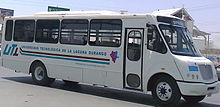
In Mexico, in addition to yellow school buses seen from the United States, various other types of buses are used in the role of student transport. As in the United States, many schools own their own fleets of school buses; school bus yellow is not a government regulation, so most buses are painted in individual school colors. Depending on capacity needs, vans, minibuses, and midibuses are also used. Among retired American school buses, some newer ones are imported into Mexico and put back into school service.
Unlike the United States and Canada, school-owned buses are not primarily used for route service (due to high cost); instead, they are often used for field trips and other related excursions. In addition to students using regular transit systems, several Mexican companies specialize in scheduled student transportation.
In Mexico City there is a special free bus service available to all the public in general; it is the "Puma-Bus" service, covering internal routes inside of the university complex located in "university city" at the south part of the same city, due to the extension of this scholar complex its operated in 10 routes that connect several points of the campus with Massive Transport Systems located near the complex (Metro, Metrobus and several local bus lines), all the routes operate from Monday to Friday, excepting those that gives services to cultural and sport centers, like the Universum Museum, Nezahualcoyotl Concert Hall and University Stadium. This service uses Low-Floor Mercedes Benz Citaro buses along with conventional units.
Oceania
Australia
In Australia, school buses vary in colour with yellow buses being rare.[65] As school route buses are almost universally run by direct government contract,[66] the livery of the bus is generally that of the contractor, with the bus commonly also being used for normal scheduled routes as required. In NSW, however, the State Government has begun a program to bring all public transport in the state under one livery[67] including strict livery regulations for new vehicles purchased for government contract use.[26] The style is typically the same as public buses in other countries, as demonstrated in the picture from Wagga Wagga, NSW (which is in the livery of the local operator). Buses used on school routes are required to bear 40 km/h (25 mph) speed limit signs on their rear and to flashing yellow lights on the front and rear, similar to those in the US and other places. When stopping or stopped, the lights flash indicating other drivers must not travel past the bus in either direction faster than 40 km/h (the same speed limit is used in 'school zones' on roads adjacent to schools at times when most students are expected to be arriving or leaving). Drivers must also cede right of way to all buses (school or otherwise) attempting to pull out from a stop. Dedicated bus lanes are common in larger cities, where buses are also allowed to move off first from traffic lights before other traffic is shown a green light. Some areas also have dedicated busways. Increasingly, jurisdictions are requiring new buses purchased for use on school routes to be fitted with seat belts and 'compartmentalisation' features, or even requiring students to use seatbelts at all times.
Private and public schools often have 'activity' style buses, sometimes in a colour matching the 'school colours' although more commonly with just the name and logo of the school on the side and/or front of the bus to save the cost of custom painting. They are used by many schools for smaller excursions, i.e. to transport a single sport team or class, in order save on external hire costs and are consequently generally also driven by school staff. In order to allow staff to drive them with a standard car or light truck licence these vehicles are generally quite small, 22 seat buses are very common in this role.
The vast majority of schools in Australia (both government and private) do not have their own buses for transporting children between the school and their home and thus most school children in Australia that do travel by bus travel on public transport buses, either on standard scheduled public transport routes, or on specific 'school travel' routes. Most school routes do not allow the general adult public to ride along with the children, although this does vary by location according to practicality (i.e. remote areas) and local regulation.
Many Australian school children travel 'free' on non fare paying bus services[68] to their local school or using a bus pass that they get issued at the beginning of the school year that covers transport with the relevant bus (and often other public transport such as train or ferry) network/s for travel to and from school only, for which the contractor in turn receives a government subsidy amount for each trip,[69] although specifics of the schemes vary from state to state, some only providing subsidy to remote or low income families.[70] Many thousands of children in Australia thus have to travel daily to school using a number of different public transport routes with different bus, train, tram and ferry networks. In most places, as of 2013, this is even achieved with a single pass.
New Zealand
In New Zealand, student transport is sometimes provided by the New Zealand Ministry of Education through school bus contractors or general bus companies. Bus companies generally have a fleet of older transit buses or coaches, different from the newer public service fleet vehicles to cater for school services.
While carrying students, buses are marked by either "SCHOOL", "SCHOOL BUS", "KURA" (Maori for "school"), or pictograms of children in black on a fluorescent chartreuse background, and a limited on the open road to 80 km/h (50 mph) . These signs all indicate that a motorist should slow to 20 km/h (12 mph) when passing a stationary bus in either direction[71][72]
See also
References
- ^ a b "School Bus Fleet Fact Book 2014". 59 (11): 34.
{{cite journal}}: Cite journal requires|journal=(help) - ^ "FAQs". American School Bus Council. Retrieved 2010-11-27.
- ^ "National Center for Education Statistics|Fast Facts". Retrieved 7 December 2014.
- ^ a b c d Highway Safety Program Guidelines: Pupil Transportation Safety. National Highway Traffic Safety Administration website. Retrieved 2010-06-23.
- ^ a b Mark Theobald (2004). Wayne Works. Coachbuilt.com. Retrieved 2010-04-26
- ^ a b "The History of School Transportation".
- ^ a b c Mark Theobald (2004). "Crown Coach". Coachbuild.com. Retrieved 2010-04-29
- ^ a b J. H. Valentine. "Crown Coach: California's Specialty Builder". Tripod. Retrieved 2010-04-27.
- ^ a b c Sandi Brockway (January 11, 2007). "Crown Coach Corporation (1932–1991)". Crown Coach Historical Society. Retrieved 2010-04-28
- ^ a b c "The Gillig Transit Coach And Pacific Schoolcoach Online Museum (archived)". Retrieved 28 March 2014.
- ^ a b "Frank W. Cyr, 'Father of the Yellow School Bus,' Dies at the Age of 95". Columbia University press release (August 3, 1995). Retrieved 2010-04-07
- ^ "School Bus Safety Community Advisory Committee" (PDF). Retrieved 2013-10-21.
- ^ a b "WA School Bus Specifications 20 September 2013" (PDF). Retrieved 2013-10-21.
- ^ "Federal Motor Vehicle Safety Standards". School Transportation News. August 8, 2009. Retrieved 2011-06-02.
- ^ "Blue Bird, Girardin Join Forces". School Bus Fleet Magazine. February 19, 2010. Retrieved 2010-04-14.
- ^ "Spartan Chassis Executes Agreement With Lion Bus Inc. for Type C School Bus Chassis". MarketWatch. 16 June 2011. Retrieved 17 June 2011.
- ^ "FAQs/Q: The school bus looks like it's hardly changed in decades. Where's the modernization". American School Bus Council. Retrieved 2010-12-03.
- ^ Spiral Design Studio. "School Bus GPS Tracking - Busfinder from". Transfinder. Retrieved 2013-04-22.
- ^ "School Bus Tracking". Vainatheya.com. Retrieved 2013-04-22.
- ^ The Fourteenth National Congress on School Transportation. "National School Transportation Specifications and Procedures (2005 Revised Edition)" (PDF). p. 40. Retrieved 2011-01-10.
- ^ "School Bus types". School Transportation News. Retrieved January 3, 2010.
- ^ The Fourteenth National Congress on School Transportation. "National School Transportation Specifications and Procedures (2005 Revised Edition)" (PDF). p. 7. Retrieved 5 January 2014.
- ^ Dr Kristin Poland of NTSB, quoted at a hearing into a fatal 2012 bus crash at Chesterfield, Missouri, in "Buses safer than cars", Circular, Bus and Coach Association of New Zealand, August 2013.
- ^ "Protecting Children from Their Own Buses by Mark D. Fisher". Retrieved January 29, 2006.
- ^ Rob Watson (June 13, 2000). "UK may get yellow school buses". BBC News. Retrieved 2010-04-07.
- ^ a b "Sydney Metropolitan Bus Service Contract-Schedule 8" (PDF). Retrieved 2013-10-20.
- ^ Colorado Minimum Standards Governing School Bus Transportation Vehicles Colorado Code of Regulations 301-25, Section 2251-R-54.02. Retrieved 2010-04-16
- ^ Bus emergency exits and window retention and release Code of Federal Regulations Title 49, Section 571.217. Retrieved 2010-04-15
- ^ a b "Code of Federal Regulations Title 49, Volume 6, Section 571.108" (PDF): 361.
{{cite journal}}: Cite journal requires|journal=(help) - ^ Illinois school bus safety standards: Lamps, Reflectors, Signals Illinois Administrative Code Title 92 (Transportation), Sec. 442.615g. Retrieved 2010-04-16
- ^ a b c School bus pedestrian safety standards Code of Federal Regulations Title 49, Section 571.131. Retrieved 2010-4-15.
- ^ a b "Canada Motor Vehicle Safety Standard - Technical Standards Document 131". Tc.gc.ca. 2011-04-04. Retrieved 2011-11-29.
- ^ Safety in the Danger Zone School Bus Fleet (September 1, 2007). Retrieved 2010-04-19
- ^ Handrail MechanicsSchool Bus Handrail Handbook. National Highway Traffic Safety Administration. Retrieved 2010-04-19.
- ^ Highway Accident Report - NTSB/HAR-01/03 National Transportation Safety Board (December 11, 2001). Retrieved 2012-07-28
- ^ Ryan Gray (August 7, 2009). "School Bus Seat Belts FAQ". School Transportation News.
{{cite web}}: Missing or empty|url=(help) - ^ a b "School Bus Seat Belts". School Transportation News. Retrieved 2010-04-16.
- ^ Janna Morrison (August 8, 2008). "NAPT Advocates Scientific Approach to Seat Belt Issue". School Transportation News. Retrieved 2010-04-16.
- ^ Arroyo, Silvia (24 October 2013). "NASDPTS Alters Its Support of Three-Point Lap/Shoulder Seat Belts on School Buses". School Transportation News. Retrieved 2 December 2013.
- ^ Susan Haigh (February 17, 2010). "Connecticut considers installing seat belts on school buses". The Hour Online. Retrieved 2010-04-16.
- ^ Seat Belts in School Buses Transport Canada. Retrieved 2010-04-19
- ^ Ryan Gray (July 8, 2009). "The History of Seat Belt Development". School Transportation News. Retrieved 2011-06-02.
- ^ "Compartmentalization". School Transportation News. Retrieved 2 December 2013.
- ^ "Review of Major School Bus Crashworthiness studies by thr National Transportation Safety Board". National Coalition for School Bus Safety. National Coalition for School Bus Safety. Retrieved 2 December 2013.
- ^ "SafeGuard school bus rollover crash test". YouTube. IMMI. Retrieved 2 December 2013.
- ^ "It's time for seat belts on school buses". SafeGuard Seating. Retrieved 2 December 2013.
- ^ "Individual, Local and Global Community Impact - American School Bus Council". Retrieved 9 April 2014.
- ^ a b "FAQs/Q: Is it healthy for my child to ride the school bus?". American School Bus Council. Retrieved 2010-12-03.
- ^ a b c Blue Bird's Alternative Fuel Product Offerings Blue Bird Corporation. Retrieved 2010-4-16
- ^ Saf-T-Liner HDX Thomas Built Buses (pdf brochure). Retrieved 2010-04-16
- ^ "IC Corporation Works with Enova Systems to Supply First Hybrid School Buses That Can Attain Up To 40 Percent Increase in Fuel Efficiency". Retrieved 9 April 2014.
- ^ "Hybrids Might be the Way of the Future but Remain Slow in Coming to School Transportation Industry". Stnonline.com. 2011-03-04. Retrieved 2011-11-29.
- ^ "Trans Tech goes green with electric school bus". Retrieved 22 January 2014.
- ^ "Are there other vehicles that can be used for school transportation? Vans?". Retrieved 2010-05-23.
- ^ "Why do some school buses look different than others, for example in color?". Retrieved 2010-05-23.
- ^ "LIS § 46.2-917.1. School buses hired to transport children". Code of Virginia. Retrieved December 4, 2005.
- ^ 校车安全事故频发折射监管缺位 超载现象严重 Retrieved 2012-3-10
- ^ "Bigger nose means bigger safety for Qingdao school buses". chinadaily.com.cn. 6 June 2011. Retrieved 18 June 2011.
- ^ a b "China goes Schoolbus Crazy". Retrieved 31 December 2013.
- ^ "American-Style Schoolbuses Make Inroads In China". Retrieved 31 December 2013.
- ^ Di johan m b Nessun nome reale + Aggiungi contatto. "bluebird | Flickr –Condivisione di foto!". Flickr.com. Retrieved 2013-04-22.
- ^ Di Wildmoreway Lena+ Aggiungi contatto. "Cheshire School Bus Bluebird V219EAL at Crewe (Flickr photo)". Flickr.com. Retrieved 2013-04-22.
- ^ http://safetycoalition.ca/node/61
- ^ http://www.qp.gov.sk.ca/documents/English/Regulations/Regulations/V2-1R10.pdf
- ^ "Bus Australia Photo Gallery". bus australia. Retrieved 2013-10-20.
- ^ "School bus contracts discourage fleet upgrades: MP". Abc.net.au. 2010-07-22. Retrieved 2013-04-22.
- ^ "Out of the blue, more buses, all dressed alike". smh.com.au. 2010-12-22. Retrieved 2013-10-20.
- ^ "Bus subsidy cuts hit students". smh.com.au. 2012-06-14. Retrieved 2013-10-20.
- ^ "NSW School Student Transport Scheme". Retrieved 2013-10-20.
- ^ "Queensland School Transport Assistance Scheme". Retrieved 2013-10-20.
- ^ Speed limits on NZTA official New Zealand Road Code website, retrieved 2010-11-14
- ^ See this article on an instance of Maori bus sign usage in Rotorua:Principal remains adamant over 'kura' bus signson Rotorua Daily Post website, retrieved 2010-11-14
External links
- School Bus Fleet Magazine - news magazine for student transportation professionals
- School Transportation News - news magazine for student transportation professionals
- U.S. DOT, NHTSA, Federal Motor Vehicle Safety Standards for School Buses (FMVSS)
- Articles that may be too long from February 2013
- Articles needing cleanup from April 2010
- Cleanup tagged articles without a reason field from April 2010
- Wikipedia pages needing cleanup from April 2010
- Articles needing cleanup from December 2009
- Cleanup tagged articles without a reason field from December 2009
- Wikipedia pages needing cleanup from December 2009
- Articles to be split from May 2014
- Types of buses
- School buses
- Student transport




